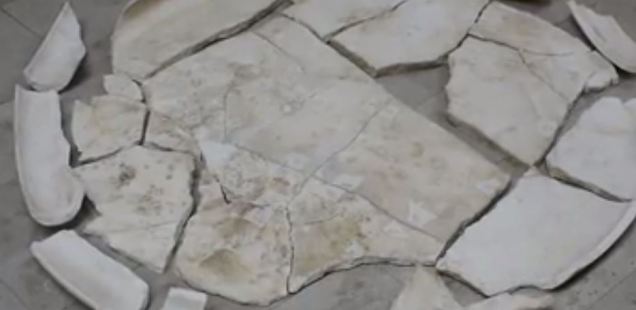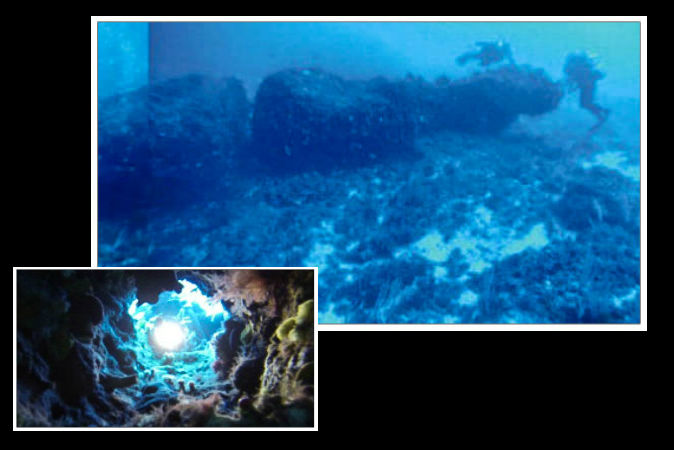5th Century Roman Marble Table Unearthed in Bulgaria
According to an Archaeology in Bulgaria report, more than 100 pieces of a household table dated to the fourth century A.D. have been found in one of the towers at the Petrich Kale Fortress, which is located on a plateau in northeastern Bulgaria near the coast of the Black Sea.
Even though the rare artefact, an ancient marble table signifying the presence of a high-ranking Roman official, has been found broken, almost all of its pieces are in place, allowing the restorers from the Varna Museum of Archaeology to put it back together.
Petrich Kale is a fortress which was in used for about 1,000 years by the medieval Eastern Roman Empire (Byzantine Empire) and the medieval Bulgarian Empire, up until the region’s conquest by the Ottoman Turks. The Petrich Kale Fortress is located in Avren Municipality, right outside of the Black Sea city of Varna (it should not be confused with the modern-day town of Petrich in Southwest Bulgaria).
The Petrich Kale Fortress was established in the Late Roman and Early Byzantine period, in the 5th century AD, and was destroyed by the end of the 6th century by barbarian invasions. It was rebuilt in the 11th century and became a major stronghold in the Second Bulgarian Empire (1185-1396). In 1154 AD, medieval Arab geographer Muhammad Al-Idrisi wrote that Petrich was a “thriving small town” to the west of Varna.
The Petrich Kale Fortress was ultimately destroyed for good by the Ottoman Turks in 1444 AD, three days before the Battle of Varna, in which they defeated the second and last Christian Crusade of the King of Poland and Hungary, Wladislaw III (also known as Varnenchik because he found his death in the Battle of Varna).
An archaeological team from the Varna Museum of Archaeology has found the white marble table from the 5th century AD inside the ruins of the southern tower of the Petrich Kale fortress during excavations in the fall of 2020, BTA reports.

“It is one of the nicest finds from our latest excavations of the Petrich Kale fortress,” says Assist. Prof. Maria Manolova-Voykova from the Varna Museum of Archaeology.
“It is a round table made of white marble, and is known in scientific literature as a table from the “raven beak” type due to its typical profile, with its top slightly curled inwards,” she explains.
Manolova-Voykova notes that similar white marble tables from the Late Roman and Early Byzantine period are known from the Eastern Mediterranean, where samples have been found in Greece and Turkey. The 5th-century table from the Petrich Kale fortress near Varna is the first one of its type to have been discovered in Bulgaria.
“Interestingly, unlike most [late Antiquity and early medieval] marble tables, which are connected with some liturgy functions from the Christian period, this type of tables have more of a secular character and household usage, as a household item showing the well-being of the respective residence,” the archaeologists say.
“Because of that, it was very interesting for us to discover this table in one of the fortress towers, which showed that the tower probably was the residence of some high-ranking administrator, perhaps dealing with the defence of the fortress, or perhaps its very governor,” she elaborates.
“Of course, for the time being, those are just conjectures but it is a fact that we found the marble table in a layer connected with the 4th century AD (i.e. the Late Roman period),” Manolova-Voykova states.

Her team has found the white marble table from the Late Roman / Early Byzantine period while clearing up construction debris inside the southern fortress tower of the Petrich Kale fortress. In addition to the shattered table, the archaeologists found inside numerous pottery fragments and Late Roman and Early Byzantine coins.
Artist and restorer Milen Marinov, who is in charge of the restoration of the 5th-century white marble table from the Petrich Kale Fortress, notes that it has been found in more than 100 pieces. Yet, it will probably be restored at almost 100% with patience and diligence as there are very few missing pieces. Marinov praised the archaeologists who recovered the precious Antiquity artefact for saving even pieces as tiny as 1 centimetre.
He adds he is using various types of glue in order to make sure that the restored table will be simultaneously solid and natural-looking once it is exhibited for the visitors of the Varna Museum of Archaeology. The museum itself boasts one of the richest archaeological collections in Bulgaria, not least the world-famous Varna Gold Treasure, the world’s oldest. The medieval Byzantine and Bulgarian fortress Petrich Kale are located 4 km north of the town of Avren, Avren Municipality near the Black Sea city of Varna, in Northeast Bulgaria (not to be confused with the modern-day town of Petrich in Southwest Bulgaria); it is also 1 km away from the Razdelna railway station.



It is located on a high rock plateau towering at up to about 100 meters, on a territory of about 30 decares (app. 7.5 acres). It had an inner and outer fortress wall as well as stone stairs carved into the rock on the north side of the plateau. Archaeological exploration indicates that the Petrich Kale Fortress was first established during the Early Byzantine period, in the 5th-6th century AD, but was destroyed towards the end of the 6th century AD.
(“Кale” is a Turkish word meaning “fortress” leftover from the Ottoman period commonly used for the numerous ruins of ancient and medieval fortresses all over Bulgaria, whose proper names are sometimes unknown.)
It was rebuilt in the 11th-12th century, the period when Byzantium conquered the First Bulgarian Empire (632/680-1018 AD) and was a major fortress of the Second Bulgarian Empire (1185-1396 AD) during the 13th-14th century. The Petrich Kale Fortress was completely destroyed in 1444 AD by the Ottoman Turks who had conquered all of Bulgaria in 1396 AD, after the Second Crusade against the Ottoman Empire led by Wladislaw III, King of Poland, Hungary, and Croatia, who perished in the Battle of Varna (which is why he is also known as Varnenchik – Warnenczyk in Polish).
The Petrich Kale Fortress was destroyed by the Ottoman Turks on November 7, 1444, three days before the Battle of Varna on November 10, 1444, in which the Christian Crusaders were defeated. Thus, the Petrich Kale Fortress is connected with the history of the Central European states Poland, Hungary, and the Czech Republic.
The Petrich Kale Fortress was first mentioned in written sources in 1154 AD by medieval Arab geographer Muhammad Al-Idrisi who described it as a “small thriving town” west of Varna. Later it was mentioned by Byzantine poet Manuel Philes (ca. 1275-1345 AD) in connection with the military campaign of Byzantine general Michael Tarchaeneiotes in Northeast Bulgaria in 1278 AD.
It was also mentioned in documents of the Ecumenical Patriarchate in Constantinople in 1369 AD and in numerous accounts of the Second Crusade of King Wladislaw III against the Ottoman Turks. The Petrich Kale Fortress near Varna was excavated by Bulgarian archaeologists in the 1970s; in recent years, the archaeological excavations were resumed in 2010 by the Varna Museum of Archaeology (Varna Regional Museum of History).



























